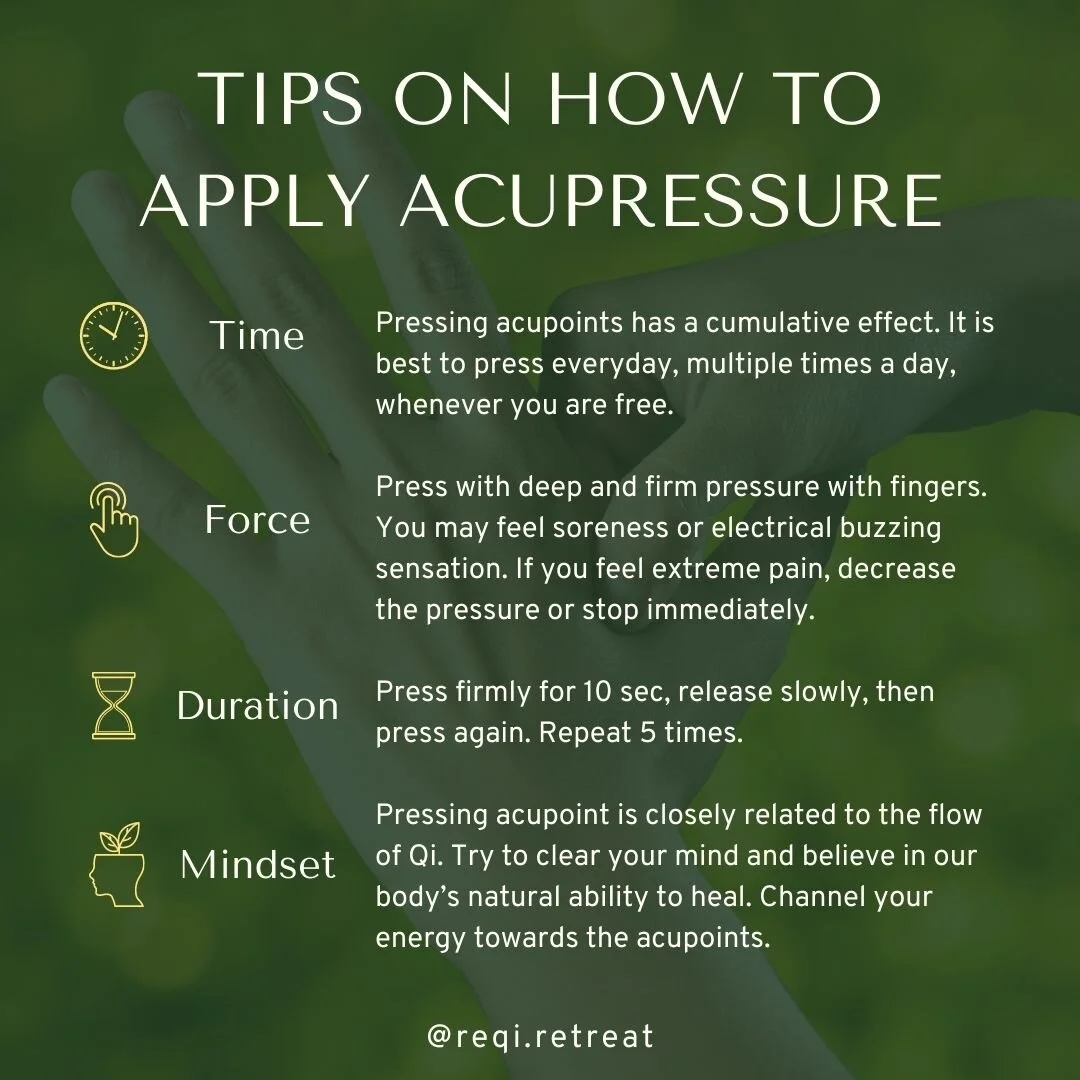5 Acupressure points for stress relief - a refresher from Re:Qi Retreat
What is Acupressure?
Our body has about 365 acupuncture points (or acupoints) located on 12 main meridians. Your vital energy, Qi runs through them to provide energy for the organs to function. Imagine a subway map. The lines are the meridians and each station is the acupoint.
When there is a block that disrupts our Qi flow, we, as the traffic controller, can unblock it by pressing the acupoints. That is acupressure. The goal of acupressure is to clear obstacles and recharge the Qi in the meridians to restore the flow of energy throughout the system [1].
Acupressure is recognized by the World Health Organization and is an integral part of Traditional Chinese Medicine with over 2000 years of history. The fact that it is still in use today is a testimony to its effectiveness in the treatment of illness and pain.
5 Acupressure points for stress relief
As a refresher from one of our popular sessions from our RE:QI Retreat, here are the 5 acupressure points that can help you decompress from life’s hectic pace [2].
Tai Chong (LV3),
He Gu (LI4),
Feng Chi (GB20),
Jian Jing (GB21),
Nei Guan (P6).
Tai Chong (LV3)
Tai Chong (LV3), also known as Great Surge, is located on your foot. You can find it 2 fingers widths above where the skin of your big toe and the next toe join. This acupoint is commonly used to treat [3][4]:
stress,
lower back pain,
high blood pressure,
menstrual cramp,
limb pain,
insomnia,
anxiety.
He Gu (LI4)
He Gu (LI4), also known as Joining Valley. Located on the highest spot of the muscle where the thumb and index fingers are connected, it is clinically used to aid [5]:
stress,
facial pain,
headache,
toothache,
neck pain.
Feng Chi (GB20)
Adding onto the list, Feng Chi (GB20) is another great acupoint that helps reduce stress [6]. Furthermore, this acupressure point is also suggested for those suffering from:
headache,
migraine,
fatigue,
low energy,
cold or flu symptoms.
You can find it by feeling for the mastoid (ear) bone and following the groove back to where the neck muscles attach to the skull.
Jian Jing (GB21)
Also known as Shoulder Well, the Jian Jing (GB21) is namely used to help with:
pain,
neck stiffness,
shoulder tension,
headache.
To find this point, draw an imaginary line between the bony prominence of the neck (C7). Then, find the top of the shoulder joint (the acromion process). This point lies midway, at the highest point of the shoulder muscle. Notably, this point may feel tender with a numbing sensation. While this may be true, the sensation varies among individuals [7].
Nei Guan (P6)
Lastly, the Nei Guan (P6), also known as the Inner Frontier. Found at 3 finger breadths below the wrist on the inner forearm, the Nei Guan is in between the 2 tendons. Often, it is used to help relieve [8]:
nausea,
upset stomach,
motion sickness,
insomnia,
headache.
Tips on applying acupressure
Right force
Using your fingers, press the point with deep and firm pressure. However, do reduce the pressure or stop immediately if you feel extreme pain. With that in mind, it is normal to feel a little soreness or an electrical buzzing sensation.
Right duration
Slowly release the pressure from your finger after pressing firmly for 10 seconds. Do repeat this cycle 5 times.
Right mindset
Pressing onto an acupoint is closely related to the flow of Qi. For instance, try to clear your mind while doing acupressure. Apart from that, you should also believe in your body's natural ability to heal.
Right time
Pressing acupoints, also known as acupressure points, has a cumulative effect. Therefore, it is best to press multiple times a day, every day. This can be done whenever you are free.
What is Re:Qi Retreat?
Re:Qi offers one-of-a-kind retreat experiences created for leaders and change-makers. From nature getaways to urban escapes, Re:Qi brings a wide array of immersive practices to support our guests’ conscious-living and holistic wellbeing journeys. Visit our website to learn more about our upcoming retreats. Join our Re:Qi community and follow @reqi. retreat to stay in the loop of latest events and special promotions.
Read Tatler's review on our inaugural Re:Qi Retreat.
References
1. UCLA Center for East-West Medicine. (2021). Acupressure for Beginners - Explore Integrative Medicine. Retrieved May 24, 2021, from Explore Integrative Medicine website: https://exploreim.ucla.edu/self-care/acupressure-and-common-acupressure-points/
2. @kanpobliss on Instagram. (2018). Retrieved May 24, 2021, from Instagram.com website: https://www.instagram.com/kanpobliss/
3. Monson, E., Arney, D., Benham, B., Bird, R., Elias, E., Linden, K., … Waggy, D. (2019). Beyond Pills: Acupressure Impact on Self-Rated Pain and Anxiety Scores. The Journal of Alternative and Complementary Medicine, 25(5), 517–521. https://doi.org/10.1089/acm.2018.0422
4. UCLA Center for East-West Medicine. (2011). Acupressure Point LV3: Liver 3 or Tai Chong - Explore Integrative Medicine. Retrieved May 24, 2021, from Explore Integrative Medicine website: https://exploreim.ucla.edu/self-care/acupressure-point-lv3/
5. UCLA Center for East-West Medicine. (2011). Acupressure Point LI4: Large Intestine 6 or He Gu - Explore Integrative Medicine. Retrieved May 24, 2021, from Explore Integrative Medicine website: https://exploreim.ucla.edu/self-care/acupressure-point-li4/
6. UCLA Center for East-West Medicine. (2011). Acupressure Point GB20: Gallbladder 20 or Feng Chi (Wind Pool) - Explore Integrative Medicine. Retrieved May 27, 2021, from Explore Integrative Medicine website: https://exploreim.ucla.edu/self-care/acupressure-point-gb20/#:~:text=Self%2DCare-,Acupressure%20Point%20GB20%3A%20Gallbladder%2020%20or%20Feng%20Chi%20(Wind%20Pool,%2C%20and%20cold%2Fflu%20symptoms
7. UCLA Center for East-West Medicine. (2011). Acupressure Point GB21: Gallbladder 21 or Jian Jing - Explore Integrative Medicine. Retrieved May 24, 2021, from Explore Integrative Medicine website: https://exploreim.ucla.edu/self-care/acupressure-point-gb21/
8. UCLA Center for East-West Medicine. (2021). Acupressure Point P6: Pericardium 6 or Nei Guan - Explore Integrative Medicine. Retrieved May 27, 2021, from Explore Integrative Medicine website: https://exploreim.ucla.edu/self-care/acupressure-point-p6/









